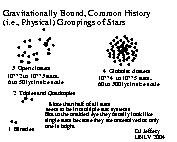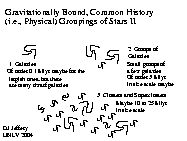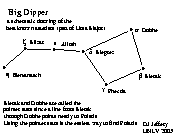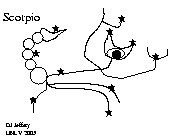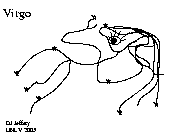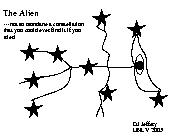- The Fixed Stars
Since prehistory humans have noticed the stars, of course. Over the course of a human life-time and even many generations don't seem to move much, except for the daily westward overall circling and the much slower overall motion due to the precession of the equinoxes.Both daily circling and precessions are physically caused by the motions of the Earth, of course---but this was not understood until after Copernicanism was accept in the course the 17th century.
These Earth-originated motions do not change the relative angular positions of the stars.
There is a small relative motion among the stars due the Earth's revolution around the Sun: the famous stellar parallax not discovered until 1838 (No-419).
Actually, the stars do have significant relative motion if you wait long enough or measure carefully enough. This motion is due to both the motion of the stars through space and the motion of the Sun through space.
-
[Remember the Celestial Sphere is just a fiction. The stars, including
Sun, are spread through three-dimensional space.]
- Physical and Unphysical Star Groups
There are real physical star groupings.By physical, we mean they are gravitationally bound and have a common history.
The smaller star groupings (multiple star systems and clusters) usually form at the same time in the same place out of the same cloud of molecular hydrogen gas (H_2) and evolve together unless gravitational perturbations from outside break them up.
In larger groupings (galaxies and clusters) the stars form over long periods of time, but due to internal evolution first of all. Galaxy mergers complicate this simple picture.
 HCG 87: Hickson Compact Group of Galaxies.
HCG 87: Hickson Compact Group of Galaxies.
The sources with points and many of the faint sources are foreground stars in our own Galaxy. The points are an artifact of the optical imaging system.
Credit: NASA/HST.
We can see some close globular star clusters and galaxies with the unaided eye.
But they just look like fuzzy stars. Historically, they were called NEBULAE which is Latin for clouds. Nowadays we usually reserve the word NEBULAE for real clouds in space of which their are lots.
We do see a few close open star clusters: most famously the PLEIADES and HYADES which we discuss below.
But most of the stars we see with the unaided eye are not in observable groups or are in unresolved multiple star systems and hence are seen as single stars.
Of course, all the unaided-eye stars are in our galaxy, the Milky Way. But we only see relatively close stars, and so don't see the Milky Way's structure except as a faint, unresolved band in the sky: i.e., the Milky Way (the milky road).
-
[The Milky Way was recognized as being made of stars with
the advent of telescope
(No-335).
GALILEO himself made this discovery in 1609 or so.]
Thus they are also randomly distributed in angle on the CELESTIAL SPHERE.
And stars that are close in angle may be very far apart in space: e.g., two close stars maybe hundreds of light-years apart along the line of sight from the Earth.
-
[Since stars vary in intrinsic luminosity by more than 10**9
(Se-605,
small star catalogue ),
the apparent brightness of any individual star is not at all a
reliable measure of that star's distance.
A bright star may have low luminosity, but be relatively close or it could have a high luminosity and be relatively distant. Without modern astronomical techniques, one simply cannot tell.]
In fact, the angular groupings of star are NOT AT ALL CLEAR-CUT.
The groupings overlap in random and complicated ways.
So different human societies have historically divided up the stars into different angular groupings.
These non-unique groupings are the CONSTELLATIONS.
In our modern understanding the CONSTELLATIONS have NO deep physical significance.
But, of course, historical societies who knew nothing of the real structure of the Milky Way thought the CONSTELLATIONS were of fundamental importance and could have deep meanings: i.e., be signs from the gods.
-
[Astrology, of course, is based on the idea that the
CONSTELLATIONS are fundamentally significant both to
the cosmos and to human nature.
Western astrology ceased to be taken seriously as a science when
in the 17th century, people realized the stars weren't
pasted on the CELESTIAL SPHERE.]
- The Constellations in History
We can't know for sure how ANCIENT CONSTELLATIONS were settled on or why.Probably the process was somewhat random and the name assigned to a constellation in many cases may have been just MNEMONIC without implying anything intrinsic about the nature of the constellation.
The BIG DIPPER was certainly so called because it looks like a set of dots outlining a dipper but certainly it was NOT so identified by all cultures: e.g., in England it is often THE WAIN (the Wagon).
But even with connecting lines (which, of course, arn't on the sky) most constellations look like the object they are named for ONLY in an abstract-in-eye-of-the-beholder way.
Without connecting lines, except for Big and Little Dippers, the constellation shapes have almost no relation to the names assigned to them.
The constellation names were no doubt often assigned to honor a god or a legend.
For example, TAURUS (the Bull) which goes back at least to the Babylonians of the 5th century BC and, perhaps, much earlier, may honor a bull god or a sacred bull. The Golden Calf of the Bible is not forgotten.
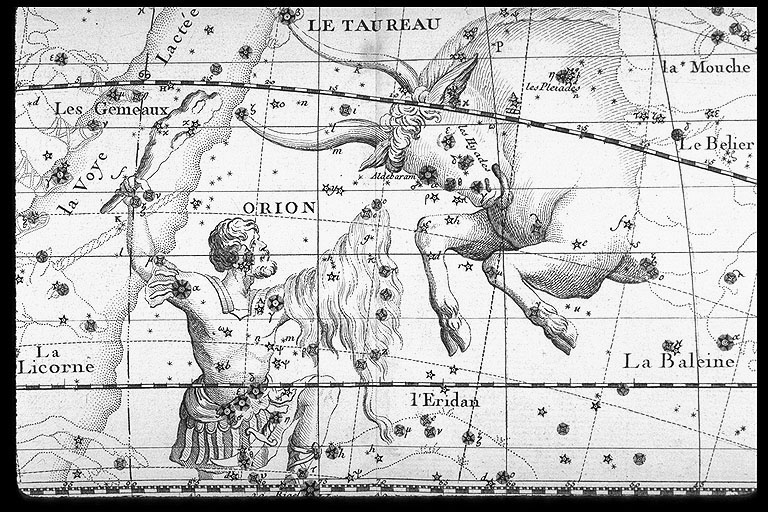 Orion and Taurus.
Orion and Taurus.
Credit: John Flamstead (Atlas celeste, Paris, 1776, Ed. J. Fortin); modern credit Linda Hall Library; more information.
When the GREEKS acquired Taurus from the Babylonians, they assigned their own bull myth to Taurus: it is ZEUS in the shape of a bull that he used to carry off Europa: but enough of that.
It is not clear to the author of these notes (that's me you know) how SACRED constellations ever were in the tradition that Europe inherited. They don't seem to have ever been directly worshipped or ritually honored so far as I can tell.
As mentioned above there have been many assignments of constellations.
For example, Chhien Lu-Chih (5th century CE) working in the CHINESE TRADITION of astronomy grouped 1464 stars into 284 CONSTELLATIONS (No-139--140).
-
The Yin-Yang symbol doesn't represent a constellation,
but astronomical interpretations of it are possible: e.g., night and
Moon (Yin) and day and Sun (Yang).
Actually the web offers a plethora of sites on the Yin-Yang that mostly don't look very trustworthy, but the Yin-Yang page of Dorothy Wilkins has references. The quote on the figure comes from a herbal medicine page, but it agrees sort of with the better documented Tao Te Ching translation of Stan Rosenthal. I've also figured out that the Tao Te Ching is not the same as the I Ching.
At least some of ANCIENT CONSTELLATIONS that have found their way into the modern constellation canon may go back to the ANCIENT MESOPOTAMIANS of 2000 BC.
The GREEKS had close contacts with BABYLONIAN ASTRONOMY after Alexander's conquest of the Persian empire (circa 330 BC) (No-17,35,39,93) and probably acquired the Babylonian constellations sometime after 330 BC.
The Greek poet Aratus describes them in his poem ``Phaenomena.'' ???
Greek astronomer PTOLEMY (circa 100--175 AD)in his catalogue groups his 1022 fixed stars in 48 constellations many (most???) following the Babylonian constellations (No-113)
Ptolemy's constellations are the basic set of classical constellations from which modern constellations of the northern hemisphere sky are derived.
These classical constellations include the Zodiac constellations.
-
Question: What is is special about the Zodiac constellations?
- They are used in astrology.
- They straddle the Ecliptic.
- They are all the animal constellations.
Answers 1 and 2 are right.They arn't all animals: there is Libra (Scales) for example.

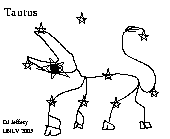
The word Zodiac is from the Greek meaning circle of animals.
It is actually a belt on the CELESTIAL SPHERE that is centered on the Ecliptic and contains, more or less, the Zodiac Constellations.
-
[In astrology, the SIGNS of the
Zodiac are technically not the constellations of the
same name, but 30 degree segments of the
Ecliptic that
constellation of that name occupied about 500 BC.
However, a popular identification of the sign with the constellation of the same name seems perfectly fair to me---there's no reason to be consistent about astrology.]
In the 16TH AND 17TH CENTURIES new constellations were added by celestial cartigraphers to group southern stars that were below the horizon of the Mediterranean area.
They just arrogated to themselves the right to make up constellations: there was no controlling authority.
The first new southern constellations seem to have been introduced by JOHANN BAYER in his Uranometria (Augsburg, 1603): he made up 12 new ones including Tucana (Toucan), Grus (Crane), and Phoenix.
 Tucana (Toucan), Grus (Crane), and Phoenix.
Tucana (Toucan), Grus (Crane), and Phoenix.
Credit: Johann Bayer ( Uranometria, Augsburg, 1603); modern credit Linda Hall Library; more information.
In the 17th and 18th centuries there was a lot of making up of new constellations to fill in gaps between the ancient ones. Many of these didn't survive at all.
For examples of 16--18th century constellation images see constellations from the Great Celestial Atlases downloaded from Linda Hall Library exhibit Out of This World: The Golden Age of the Celestial Atlas.
- The Modern Official Constellations
In 1922, the INTERNATIONAL ASTRONOMICAL UNION (IAU) at it's first meeting decided---perhaps arrogating to itself the right to decide---on a fixed list of 88 constellations. "The IAU decides on the Constellations"
"The IAU decides on the Constellations"
These include many of the traditional constellations of Ptolemy and some of the modern inventions particularly for southern hemisphere sky.
A good list of the modern 88 constellations is at the Munich Astro Archive .
The Archive gives the astronomical details and the mythical background if there is one.
-
[The constellations include 14 humans, 19 land animals, 10 water
creatures, 9 birds, 2 insects, 2 centaurs, a head of hair
(Coma Berenices [Berenice's Hair]),
a serpent, a dragon, a flying hourse (Pegasus), a river, and
29 inanimate objects including a telescope and a ship's sail.
There are more objects in the above enumeration because some constellations include multiple objects.]
Any of these non-IAU angular groupings, is an ASTERISM.
-
[Asterism is from the Greek asterismos derived from asterizein meaning
to mark with stars Ba-76).
The most famous ASTERISM is the Big Dipper which is still often called a constellation in it's own right, but it is not in the official IAU 88 constellation list: it is part of Ursa Major (the Great Bear).
A good photographic image of Ursa Major is at the Stellar Scenes site of Naoyuki Kurita: Naoyuki Kurita's Ursa Major (the Great Bear).
Similarly the Little Dipper (part of Ursa Minor [the Small Bear]) is an asterism. Polaris (the North Star or the Pole Star) is at the end of the handle of the Little Dipper: in year 2000 epoch coordinates it is only 44 arcminutes, 9 arcseconds from the North Celestial Pole (NCP).
-
[To find Polaris easily locate the Big Dipper (which
overall is a much brighter, more obvious asterism than
the Little Dipper) and the two stars farthest from
the handle: a line from these stars (called the pointer stars) up from the
Big Dipper runs pretty nearly into Polaris:
see the
northern winter-night sky map.]
- Why does Astronomy Still Bother with Constellations?
Why do we astronomers still want constellations? As we argued above we now understand that they have no fundamental physical significance.Partially, it is just that astronomers and folks in general are FOND of their constellations---they're traditional and part of the romance of astronomy---so we should keep them in an orderly fashion.
There is also a practical use for both professional and amateur astronomers.
The modern constellations (i.e., patches of the sky) provide a useful rough and easily memorized location system--- the constellations act as SKYMARKS.
One can always locate an object precisely using declination and right ascension, but for just a ROUGH LOCATION one can use constellation mnemonics: e.g., for Polaris as described above.
Also for a rough position one can say the object is in such or such a constellation.
For example, one can say there is a bright SUPERNOVA in Virgo: this is a relatively frequent occurrence since there is a large nearby cluster of galaxies in Virgo (the Virgo cluster), and so bright supernovae are relatively frequently found in Virgo.
-
[Supernovae occur only a few times per century in large galaxies,
but if you are looking at many galaxies in a cluster you'll see them
much more often.
The locution object x is in constellation y, although perfectly natural given the modern definition of constellation, does have astrological suggestiveness as if there was a magic sympathy between object and constellation---Venus is Virgo or Venus is in Taurus---but this is just a vestige of where we've come from.
- Examples of Physical Star Groups
As mentioned above constellations are generally NOT physical groups of stars: in fact none of the IAU 88 constellations are physical groups???.But some of the asterisms are physical groups. The most famous are probably the PLEIADES (M45) (see below and SEDS Pleiades or Steven Gibson's Pleiades ) and HYADES (see SEDS Hyades) which are both OPEN STAR CLUSTERS in Taurus.
An open cluster is group of stars formed in a common star forming region.
Because of spatial compactness and because the stars formed nearly at the same time (by astronomical standards), open clusters are of great astrophysical importance in learning star properties.
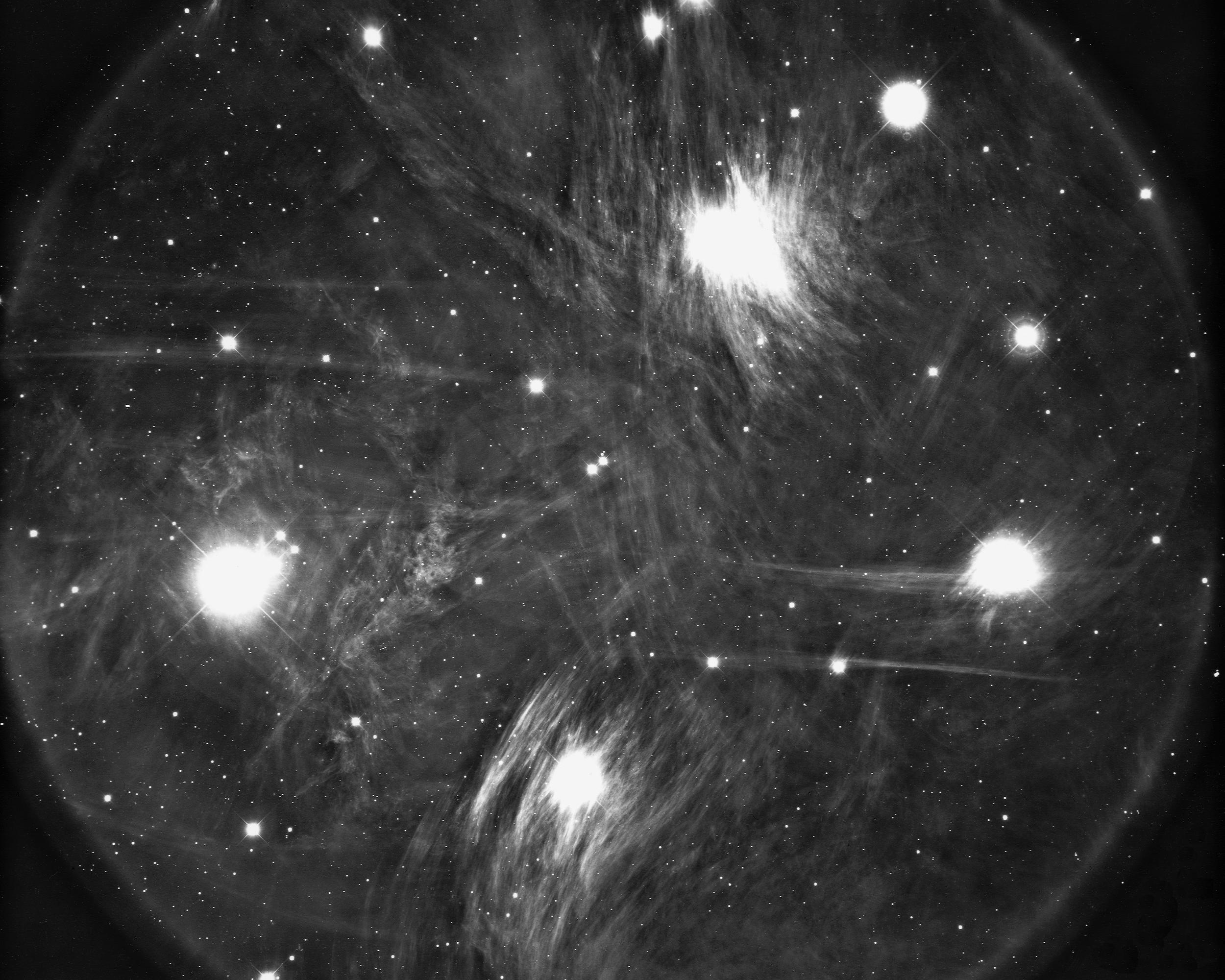
The Pleiades, an open star cluster, in Taurus centered about 127 pc away and spanning about 13 pc.
The stars in this image are really unresolved point sources.
The round and pointed stars are finite in size because of finite resolution of the imaging system.
The Pleiades stars themselves have a glow around them because their light is being reflected from interstellar dust.
Credit: NOAO/AURA/NSF.
A good image of Taurus showing the Pleiades and Hyades is at the Stellar Scenes site of Naoyuki Kurita: Naoyuki Kurita's Taurus.
The Hyades are the stars about Aldebaran. But Aldebaran is not part of the physical Hyades cluster: it is a foreground star at about 60 lyr; the Hyades are at about 150 lyr---they are closest star cluster to Earth, except for the very spread out Ursa Major cluster.
As groups of stars the Pleiades and Hyades have been known in many cultures since prehistoric times. Hesiod (circa 8th century BC) mentions them in his Works and Days:
-
But when the Pleiades and Hyades
And great Orion sink, the time has come
To plough; and fittingly the old year dies.
---We-78All good rural advice I assume. Chaucer cleverly alludes to them in the Canterbury Tales: see Chaucer.
-
[The name Pleiades may be derived from
Pleione (a mythical mother)
which is also the name of one of the brighter stars.
In Europe they have also been called the Seven Sisters and
their Japanese name is Subaru like the car and the telescope.]
To find the Pleiades, one can use the constellations as landmarks---well SKYMARKS
First, locate Orion and Sirius (the brightest star in the sky) off to the lower left of Orion (south-east on the sky). A line from Sirius though the belt of Orion and then through the bright orangy Aldebaran (the eye of Taurus) leads pretty much to the Pleiades---a distinct close little group of six or more stars.
The northern constellations map below illustrates the method.
 The northern constellations: a mid-winter night-time
view judging from the position of old man Orion.
The northern constellations: a mid-winter night-time
view judging from the position of old man Orion.
The Milky Way is not displayed, but it passes through Cassiopeia and over the north-east shoulder of Orion (where one finds Betelgeuse).
Credit: Mount Wilson Observatory StarMap program by Bob Donahue. StarMap is fortran program, but it's been broke since 2000jan03. Download site: Univ. of Tennessee, Knoxville Astro course; more precisely here.
- Star Names
Part of the sky lore that goes with constellations are the TRADITIONAL STAR NAMES given to the brightest stars.These names have, of course, derived from a hodge-podge of sources over the millennia.
For example, the brightest star is SIRIUS (the Dog Star) in the constellation Canis Major (the Big Dog or just the Dog). Sirius is a Latinization of the Greek Seiros meaning scorching or scorcher.
This is name is because Sirius has it's heliacal rising is in mid-July (No-12), and heralds the hottest time of the year in the northern hemisphere---the Dog days.
Many star names are Latinizations of Arabic names. For example, ALDEBARAN, the brightest star in Taurus---it's the eye of the Bull with a distinct orangy color---is in original Arabic Ad-Dabaran meaning the Follower (of Pleiades).

Possibly Al Sufi (903--986), the Persian astronomer who fixed many of the names of the fixed stars in his Book of the Fixed Stars.
Credit: Medieval Islamic artist; modern credit ??? (but believed to be public domain); download site Wolfgang Steinicke's list of NGC/IC observers.
Johann Bayer in his Uranometria made the innovation of naming stars according to their relative brightness in the constellation in which they were found (Se-12).To indicate their brightness he used GREEK LETTERS in order of decreasing brightness: alpha for brightest, beta for 2nd brightness, gamma for third brightest, etc.
 The Greek alphabet: alpha, beta, gamma, delta, ...
The Greek alphabet: alpha, beta, gamma, delta, ...
To indicate the constellation he appended the Latin possessive form of the constellation name: hence Aldebaran, the brightest star, in Taurus becomes ALPHA TAURII or, for short, ALPHA TAU.
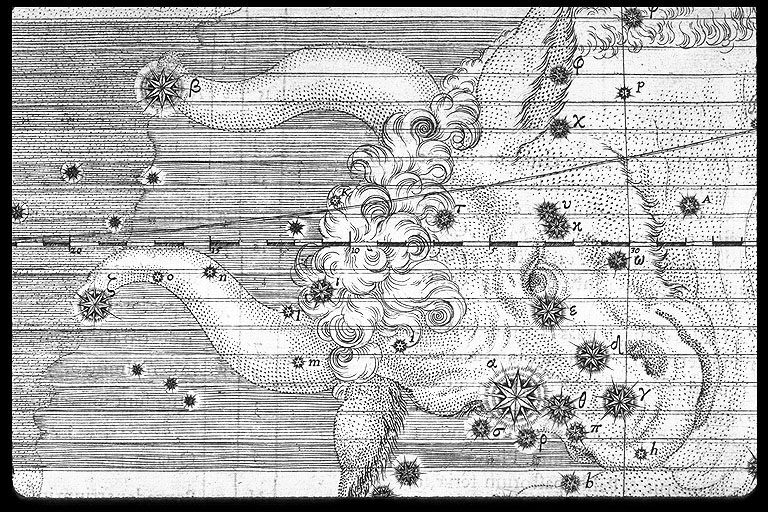 Taurus (detail) with Aldebaran (Alpha Taurii).
Taurus (detail) with Aldebaran (Alpha Taurii).
Credit: Johann Bayer ( Uranometria Augsburg, 1603); modern credit Linda Hall Library; more information.
Bayer's assignment of brightnesses doesn't always accord with the modern accurate assignment---in fact the agreement is pretty poor---but his nomenclature is retained.
The Bayer names complement and supplement the traditional names: they don't replace them. The invention of the telescope in 1608 (No-328, Lecture 4.8), of course, revealed myriads of new faint stars and Bayer's system became inadequate eventually.
Other star name systems became necessary.
The most basic of these is simply to name the star by its declination and right ascension coordinates.
A longer discussion of modern star naming systems is given by Jim Kaler of the University of Illinois.
- Constellation Sites
- Constellations from the Great Celestial Atlases Downloaded from Linda Hall Library exhibit.
- Constellation FAQs Useful list of tidbits. The ``who invented them'' is probably most unique. But it's wrong about the Greeks getting the Babylonian constellations from Egypt. The Greeks probably got them directly from the Babylonians (No-17,35,39,93).
- Constellation Photos Good for private study, not for class showing.
- Earth & Sky radio show star name pronounciation Just in case you want to know how to pronounce Fomalhaut.
- Hawaiian Astronomical Society Constellation List Decent maps for study, but not for class showing and not downloadable.
- Ian Redpath's Star Tales A sampler from his book it seems. Just the standard myths, but he does have some obsolete constellations.
- Jordanian Astronomical Society on Arabic star names I trust this is an authoritative source.
- Jim Kaler on constellations Good pictures with lines and Bayer's Uranometria images too.
- Jim Kaler on star names Good on modern star naming procedures.
- Jim Kaler on stars A big list of stars and descriptions is available.
- John Walker's Your Sky Catalogs of charts including constellations. They arn't images and they're a bit cluttered, but Walker declares them all to be public domain.
- Linda Hall Library exhibit Out of This World The Golden Age of the Celestial Atlas. I hope this page doesn't go away. Images are free for non-commercial use with credit given.
- Mark Hurn's index of star names.
- Mount Wilson's StarMap by Bob Donahue This great service is now broke since 2000jan03 and no one wants to fix it.
- Munich Astro Archiv Constellation Pages Good for modern astronomical objects in constellations. Some star maps, but the constellation lines are too faint. Supported by one of my old afiliations: the Sternwarte Muenchen.
- Naoyuki Kurita's Constellation Pages Best images so far and with lines. Really good actually. They are long exposures to bring out star colors, faint stars, and nebulae.
- Steven Gibson's star name meanings. The Stars are ordered by constellation.
- Constellation Images
-

The northern constellations: a mid-winter night-time view judging from the position of old man Orion.
The Milky Way is not displayed, but it passes through Cassiopeia and over the Betelgeuse (alpha Ori) (eastern) shoulder of Orion.
Credit/Permission: Uncertain since it was created by someone using the Mount Wilson Observatory StarMap program by Bob Donahue. StarMap is a fortran program, but it's been off-line since at least 2000jan03. / Uncertain since no permissions have be specified at the download site.
Download site: Univ. of Tennessee, Knoxville Intro Astro course; more precisely here.
-
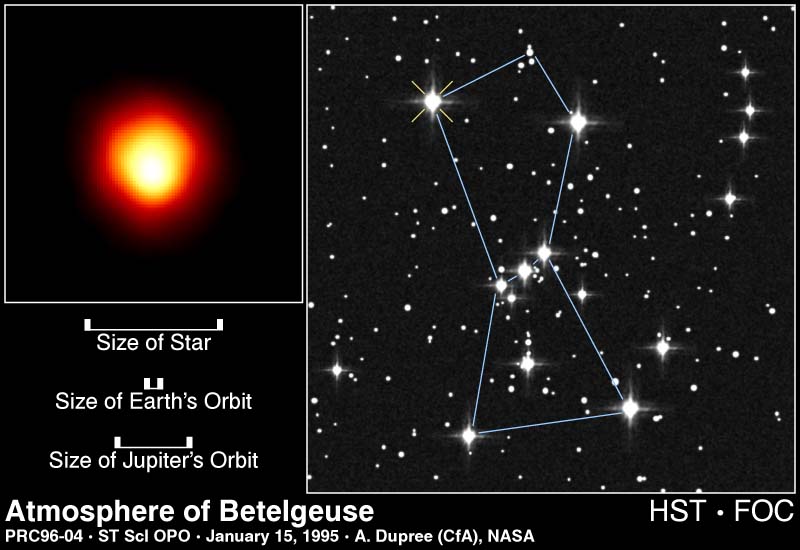 Betelgeuse imagined by the HST.
Betelgeuse imagined by the HST.
Betelgeuse is an M1 Iab red supergiant star. It is 131 pc from Earth.
It is the eastern shoulder of Orion: i.e., the left shoulder on the image.
Orion is, of course, a giant hunter of Greek mythology: he pursued the Pleiades and was slain by Artemis (Ba-855).
The lines joining the stars are NOT present on the sky, of course.
Orion is one of the three constellations anyone can recognize: the other two are the Big Dipper (officially an asterism in Ursa Major) and Cassiopeia (the big W): bother are in the northern sky and are all-year constellations.
Credit: NASA/HST
- Naoyuki Kurita's Andromeda The three brightest stars left to right are Almaak, Mirach, and Alpheratz (Sirrah). The fuzzy object some ways above Mirach and just above the a line corner is the Andromeda Galaxy (M31): it is the farthest naked-eye object one can see at ???? Mpc and the closest large galaxy to us. Al-Sufi (903--986) seems to have been the first to note it.
- Naoyuki Kurita's Aquila
- Naoyuki Kurita's Ophiuchus
- Naoyuki Kurita's Orion
- Naoyuki Kurita's Taurus with Saturn and the Pleiades. See a close-up of the Naoyuki Kurita's Pleiades
- Naoyuki Kurita's Ursa Major (the Great Bear)
-

